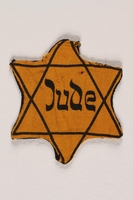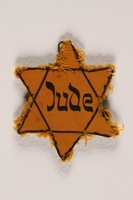Overview
- Date
-
use:
approximately 1942-1944
- Geography
-
issue:
Netherlands
- Credit Line
- United States Holocaust Memorial Museum Collection, Gift of the Estate of Harry Goldsmith
- Markings
- front, center, black ink : Jood [Jew]
Physical Details
- Language
- Dutch
- Classification
-
Identifying Artifacts
- Category
-
Badges
- Object Type
-
Star of David badges (lcsh)
- Physical Description
- Yellow cloth badge in the shape of a 6 pointed Star of David. The star outline is formed from 2 overlapping, dyed triangles and has Dutch text in the center. Printed guide marks for cutting are visible around the edge of the cloth.
- Dimensions
- overall: Height: 4.500 inches (11.43 cm) | Width: 3.875 inches (9.843 cm)
- Materials
- overall : cloth, dye, ink
Rights & Restrictions
- Conditions on Access
- No restrictions on access
- Conditions on Use
- No restrictions on use
Keywords & Subjects
- Topical Term
- Holocaust, Jewish (1939-1945)--Netherlands.
Administrative Notes
- Legal Status
- Permanent Collection
- Provenance
- The Star of David badge was donated to the United States Holocaust Memorial Museum in 1988 by Kenneth and Ellen Goldsmith, on behalf of the Estate of Harry Goldsmith.
- Record last modified:
- 2022-07-28 18:21:07
- This page:
- https://collections.ushmm.org/search/catalog/irn771
Download & Licensing
In-Person Research
- By Appointment
- Request 21 Days in Advance of Visit
- Plan a Research Visit
- Request to See This Object
Contact Us
Also in Harry Goldsmith collection
The collection consists primarily of stamps, envelopes, postcards, correspondence, postal cancellations, scrip, identification cards, photographs, work permits, ration cards, and receipts relating to the Holocaust in various countries, ghettos, and concentration camps. The scrapbooks are organized by concentration camp, location, ghetto, and period
Date: 1930-1948
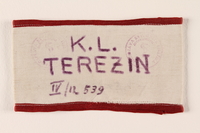
Armband identifying a Jewish inmate of Theresienstadt
Object
Armband identifying Jewish prisoner in Theresienstadt.
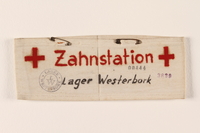
Armband identifying a dental station worker in Westerbork
Object
Armband identifying Westerbork prisoner; dental station worker Acquired by Harry Goldsmith with the assistance of his son Kenneth, late 1960s-late 1970s. Westerbork: camp situated in the NE Netherlands, near the town of that name in province Drenthe, 1942-1944, transit camp for Jews being deported from Netherlands to Eastern Europe.
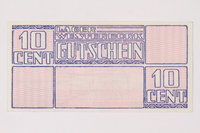
Westerbork transit camp voucher, 10 cent note
Object
Westerbork voucher, value 10 cents, acquired by Harry Goldsmith. This scrip was issued in Westerbork transit camp beginning February 15, 1944. Inmates were not allowed to have currency, which was confiscated. The vouchers [gutschein] were distributed as an incentive for doing work. Netherlands was occupied by Germany in May 1940. The camp, in northeast Holland, was originally set up by the Dutch in 1939 to intern Jewish refugees. In July 1942, the German security police and the SS turned it into a transit camp to hold prisoners before deporting them to concentration camps in the east, where most perished. From July 1942 - September 3, 1944. nearly 200,000 Jews were deported from the camp. Most inmates had short stays at the camp. However, there were about 2000 longterm detainees who helped run the camp or were exempt from deportation. The vouchers were used with this population, most of whom were deported before the camp was liberated on April 12, 1945.
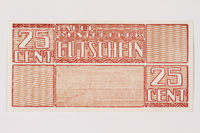
Westerbork transit camp voucher, 25 cent note
Object
Westerbork voucher, value 25 cents, acquired by Harry Goldsmith. This scrip was issued in Westerbork transit camp beginning February 15, 1944. Inmates were not allowed to have currency, which was confiscated. The vouchers [gutschein] were distributed as an incentive for doing work in four denominations: 10, 25, 50, and 100 cents. Netherlands was occupied by Germany in May 1940. The camp, in northeast Holland, was originally set up by the Dutch in 1939 to intern Jewish refugees. In July 1942, the German security police and the SS turned it into a transit camp to hold prisoners before deporting them to concentration camps in the east, where most perished. From July 1942 - September 3, 1944. nearly 200,000 Jews were deported from the camp. Most inmates had short stays at the camp. However, there were about 2000 longterm detainees who helped run the camp or were exempt from deportation. The vouchers were used with this population, most of whom were deported before the camp was liberated on April 12, 1945.
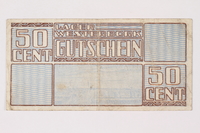
Westerbork transit camp voucher, 50 cent note
Object
Westerbork voucher, value 50 cents, acquired by Harry Goldsmith. This scrip was issued in Westerbork transit camp beginning February 15, 1944. Inmates were not allowed to have currency, which was confiscated. The vouchers [gutschein] were distributed as an incentive for doing work. Netherlands was occupied by Germany in May 1940. The camp, in northeast Holland, was originally set up by the Dutch in 1939 to intern Jewish refugees. In July 1942, the German security police and the SS turned it into a transit camp to hold prisoners before deporting them to concentration camps in the east, where most perished. From July 1942 - September 3, 1944. nearly 200,000 Jews were deported from the camp. Most inmates had short stays at the camp. However, there were about 2000 longterm detainees who helped run the camp or were exempt from deportation. The vouchers were used with this population, most of whom were deported before the camp was liberated on April 12, 1945.
Harry Goldsmith papers
Document
Inludes envelopes that once contained letters sent to the Jewish Labor Committee in New York from displaced persons and those who worked with them in Poland, Austria, and Italy after WWII. Also includes examples of antisemitic propaganda; a letter from an inmate at Westerbork; documents related to Julia Petzer, from Austria; and issues of "Information zur Judenfrage," released by the "Welt-Dienst" of the Internationales Institut zur Aufklaerung ueber die Judenfrage, Frankfurt.
Harry Goldsmith collection, Book 1
Document
The collection consists primarily of stamps, envelopes, postcards, correspondence, postal cancellations, scrip, identification cards, photographs, work permits, ration cards, and receipts relating to the Holocaust in various countries, ghettos, and concentration camps. The scrapbooks are organized by concentration camp, location, ghetto, and period. Book 1 concerns the Theresienstadt Ghetto.
Harry Goldsmith collection, Book 2
Document
The collection consists primarily of stamps, envelopes, postcards, correspondence, postal cancellations, scrip, identification cards, photographs, work permits, ration cards, and receipts relating to the Holocaust in various countries, ghettos, and concentration camps. The scrapbooks are organized by concentration camp, location, ghetto, and period. Book 2 concerns the Theresienstadt Ghetto.
Harry Goldsmith collection, Book 3
Document
The collection consists primarily of stamps, envelopes, postcards, correspondence, postal cancellations, scrip, identification cards, photographs, work permits, ration cards, and receipts relating to the Holocaust in various countries, ghettos, and concentration camps. The scrapbooks are organized by concentration camp, location, ghetto, and period. Book 3 contains materials concerning Dachau, Spittal, Postelberg, Mittelbau, Biberach, Liebenau, Natzweiler, Tittmoning, Laufen, and Drulle.
Harry Goldsmith collection, Book 4
Document
The collection consists primarily of stamps, envelopes, postcards, correspondence, postal cancellations, scrip, identification cards, photographs, work permits, ration cards, and receipts relating to the Holocaust in various countries, ghettos, and concentration camps. The scrapbooks are organized by concentration camp, location, ghetto, and period. Book 4 concerns Buchenwald.
Harry Goldsmith collection, Book 5
Document
The collection consists primarily of stamps, envelopes, postcards, correspondence, postal cancellations, scrip, identification cards, photographs, work permits, ration cards, and receipts relating to the Holocaust in various countries, ghettos, and concentration camps. The scrapbooks are organized by concentration camp, location, ghetto, and period. Book 5 concerns Treuenbrietzen, Selterhof, Ravensbrück, Gross-Rosen, Tutthof, Litzmannstadt, Radomski, Tomaschow, Langenstein, Damgarten, Lebrechtsdorf, and Dibog.
Harry Goldsmith collection, Book 6
Document
The collection consists primarily of stamps, envelopes, postcards, correspondence, postal cancellations, scrip, identification cards, photographs, work permits, ration cards, and receipts relating to the Holocaust in various countries, ghettos, and concentration camps. The scrapbooks are organized by concentration camp, location, ghetto, and period. Book 6 concerns Flossenbürg, Nauthausen, Bistrai, Neuengamme, Bergen Belsen, Litten, Camp Drutte, Sabac, and Neu-Sustrum.
Harry Goldsmith collection, Book 7
Document
The collection consists primarily of stamps, envelopes, postcards, correspondence, postal cancellations, scrip, identification cards, photographs, work permits, ration cards, and receipts relating to the Holocaust in various countries, ghettos, and concentration camps. The scrapbooks are organized by concentration camp, location, ghetto, and period. Book 7 concerns Otwoc, Lemberg, Cracow Ghetto, Belzec, Heruschau, Opole, Villijampole, Bochnia, Izbica, Modliborzyce, Lublin, Krosno, Kutno, Kielce, Kolomea, and Lowitsh.
Harry Goldsmith collection, Book 8
Document
The collection consists primarily of stamps, envelopes, postcards, correspondence, postal cancellations, scrip, identification cards, photographs, work permits, ration cards, and receipts relating to the Holocaust in various countries, ghettos, and concentration camps. The scrapbooks are organized by concentration camp, location, ghetto, and period. Book 8 concerns Scheveningen, Minsk, Kamionka, Sajczyce, Westerbork, Sluis, Herzogenbusch, Graudenz, Hungary, Hellevoetshuis, Bulgaria, Jaworzno, Strzemieszyce, and Michiesgestel.
Harry Goldsmith collection, Book 9
Document
The collection consists primarily of stamps, envelopes, postcards, correspondence, postal cancellations, scrip, identification cards, photographs, work permits, ration cards, and receipts relating to the Holocaust in various countries, ghettos, and concentration camps. The scrapbooks are organized by concentration camp, location, ghetto, and period. Book 9 concerns Camp de Breus, Camp du Vernet, Decebedou, Les Milles, Corropoli, Ferramonti, Rodi, Solofra, Campagna, Perpignan, Vinchiaturo, and Potenza.
Harry Goldsmith collection, Book 10
Document
The collection consists primarily of stamps, envelopes, postcards, correspondence, postal cancellations, scrip, identification cards, photographs, work permits, ration cards, and receipts relating to the Holocaust in various countries, ghettos, and concentration camps. The scrapbooks are organized by concentration camp, location, ghetto, and period. Book 10 concerns internment camps at Mauritius, the Isle of Man, Cyprus, Morroco, and Andalusia.
Harry Goldsmith collection, Book 11
Document
The collection consists primarily of stamps, envelopes, postcards, correspondence, postal cancellations, scrip, identification cards, photographs, work permits, ration cards, and receipts relating to the Holocaust in various countries, ghettos, and concentration camps. The scrapbooks are organized by concentration camp, location, ghetto, and period. Book 11 concerns the Gurs, de Argeles, and Vittel camps.
Harry Goldsmith collection, Book 12
Document
The collection consists primarily of stamps, envelopes, postcards, correspondence, postal cancellations, scrip, identification cards, photographs, work permits, ration cards, and receipts relating to the Holocaust in various countries, ghettos, and concentration camps. The scrapbooks are organized by concentration camp, location, ghetto, and period. Book 12 concerns Bendsburg.
Harry Goldsmith collection, Book 13
Document
The collection consists primarily of stamps, envelopes, postcards, correspondence, postal cancellations, scrip, identification cards, photographs, work permits, ration cards, and receipts relating to the Holocaust in various countries, ghettos, and concentration camps. The scrapbooks are organized by concentration camp, location, ghetto, and period. Book 13 concerns Auschwitz.
Harry Goldsmith collection, Book 14
Document
The collection consists primarily of stamps, envelopes, postcards, correspondence, postal cancellations, scrip, identification cards, photographs, work permits, ration cards, and receipts relating to the Holocaust in various countries, ghettos, and concentration camps. The scrapbooks are organized by concentration camp, location, ghetto, and period. Book 14 concerns the Warsaw Ghetto, Tarnow, and Pargzew.
Harry Goldsmith collection, Book 15
Document
The collection consists primarily of stamps, envelopes, postcards, correspondence, postal cancellations, scrip, identification cards, photographs, work permits, ration cards, and receipts relating to the Holocaust in various countries, ghettos, and concentration camps. The scrapbooks are organized by concentration camp, location, ghetto, and period. Book 15 concerns Sachenhausen and Oranienburg.

